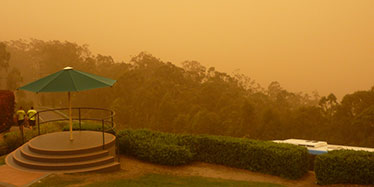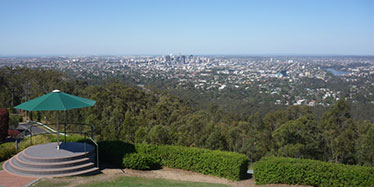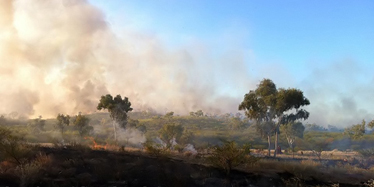Bushfires and dust storms
Air quality in Queensland is generally good. Monitored pollutants have exceeded national standards or guidelines very few times.
There have been periods of elevated particle levels in all areas of Queensland where monitoring takes place, largely due to dust storms and bushfires.
Particles less than 2.5 micrometres in diameter (PM2.5) levels occasionally exceed the National Environment Protection Measure (Air NEPM) standards, primarily as a result of smoke from vegetation burning.
There have also been occasional breaches of the Air NEPM standard for particles less than 10 micrometres in diameter (PM10), often linked to windblown dust episodes during dry periods. Particularly during 2002, 2003, 2005, 2009, 2018 and 2019, more days when PM10 levels were above the standard of 50 microgram per cubic metre (μg/m3) were measured due to major dust storms and/or bushfires.
Dust storms
Dust storms affect air quality. Dust plumes typically originate from inland areas where:
- land management practices and extended drought reduce ground cover
- high winds transport the eroded soil over long distances.
In September 2009, a large dust storm (the Red Dawn dust storm) moved across eastern Australia, extending from the New South Wales–Victorian border to the Gulf of Carpentaria.
Fine, dry sediment from inland evaporation pans and floodplains in central Australia, deposited by the floods in February 2009 and whipped up by strong winds, associated with the passage of two weather fronts, became that extensive dust storm.
The following images show the impact of this dust storm on Brisbane’s air quality.


Bushfires
Fires are common in Australia and include:
- bush and grass fires
- hazard-reduction burns
- cane burning
- grazing pasture improvement burns.
Both controlled and uncontrolled burning generates large amounts of smoke, ash and dust. Uncontrolled burning during extreme weather conditions (dry and windy) are less common, but often burn more intensely over a wider area. Depending on fuel loads, topography and climatic conditions, uncontrolled burning can have a significant impact on air quality.

Impacts
The immediate impacts of dust storms and bushfires include:
- decrease in air quality
- health problems due to inhalation of fine particles—this can worsen respiratory and cardiovascular disease particularly in children, the elderly and those with pre-existing medical conditions
- reduction in visibility
- disruption to transport
- residues on surfaces.
The loss of soil from the source can also impact on water quality as soil is carried away into waterways and wetlands.
Bushfires also release large amounts of ozone precursors and carbon dioxide into the atmosphere and have the potential for widespread damage to property, environment and human life.
View the live air data service to check the current levels of particles in the atmosphere at monitoring stations in the Queensland network.
Reducing impacts
Queensland Health has developed a set of recommended health actions based on particle levels to support and inform the community on what actions to take to protect their health during a smoke or dust event.
The health actions are based on hourly PM2.5 measurements and provide separate advice on preventative actions for the general public and for individuals who are potentially more sensitive. Sensitive groups include:
- people with a heart or lung condition, including asthma
- people over the age of 65
- infants and children
- pregnant women.
Please note that these are recommendations only. Follow directions from emergency services and advice from your doctor at all times. If you are feeling unwell, please seek medical advice from a doctor, or call 13 HEALTH (13 43 25 84) for advice.
View the current smoke and dust health action levels to check if you need to take any actions in response to current levels of particles in the atmosphere at monitoring stations in the Queensland network.


